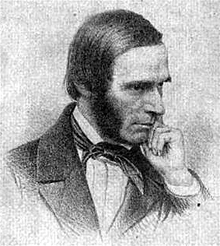ALBERT GALLATIN HOIT
(American, 1809-1856) Portrait and landscape painter, Albert Gallatin Hoit (also spelled Hoyt) was born in Sandwich, New Hampshire in 1809, the son of state legislator General Daniel Hoit. Albert graduated from Dartmouth College in 1829. He appears to have been self-taught as an artist, but gave painting lessons while attending college. During the 1830s he painted in New Hampshire, Vermont, Maine and New Brunswick, Canada. Beginning in 1836 he had a studio in Fredericton, New Brunswick, where he received many portrait commissions, including all of the judges of the New Brunswick Supreme Court. After 1839 Hoit made his home in Boston. The artist’s most important portrait, of General William Henry Harrison (1773-1841), ninth president of the U.S., was painted in 1840. Hoit was one of the few artists to whom Harrison granted a portrait sitting. This privilege was due to Hoit’s strong Whig connections; the portrait had been commissioned by a Whig association, and Judge Salmon P. Chase, who would become Chief Justice–a friend and Dartmouth classmate of Hoit’s–arranged the sitting. Chase declared the finished painting “a fine likeness and a good picture.” It proved to be the last portrait of Harrison done from life. Hoit spent from 1842 to 1844 in Europe. When he returned he established his home in Roxbury, Massachusetts. He revisited the Canadian maritime provinces briefly in 1848. Hoit was one of the twenty founders of the original Boston Art Club, which met for the first time in 1855. His work is held among the collections of the National Gallery of Canada, in Ottawa; the National Portrait Gallery, Washington, D.C.; the Montpelier General Henry Knox Museum, Thomaston, Maine; the Moffatt-Ladd House, Portsmouth, New Hampshire; Fruitlands Museum, Harvard, Massachusetts; the University of New Brunswick; the Nova Scotia Supreme Court, Halifax; the Sandwich Historical Society Museum, New Hampshire; and the New Brunswick Museum. The artist died in 1856 at the age of forty-seven. His obituary in The Crayon recalls him as “one of the best and truest of men” and an artist “who lived and died as an honor to the profession.”
Portrait and landscape painter, Albert Gallatin Hoit (also spelled Hoyt) was born in Sandwich, New Hampshire in 1809, the son of state legislator General Daniel Hoit. Albert graduated from Dartmouth College in 1829. He appears to have been self-taught as an artist, but gave painting lessons while attending college. During the 1830s he painted in New Hampshire, Vermont, Maine and New Brunswick, Canada. Beginning in 1836 he had a studio in Fredericton, New Brunswick, where he received many portrait commissions, including all of the judges of the New Brunswick Supreme Court. After 1839 Hoit made his home in Boston. The artist’s most important portrait, of General William Henry Harrison (1773-1841), ninth president of the U.S., was painted in 1840. Hoit was one of the few artists to whom Harrison granted a portrait sitting. This privilege was due to Hoit’s strong Whig connections; the portrait had been commissioned by a Whig association, and Judge Salmon P. Chase, who would become Chief Justice–a friend and Dartmouth classmate of Hoit’s–arranged the sitting. Chase declared the finished painting “a fine likeness and a good picture.” It proved to be the last portrait of Harrison done from life. Hoit spent from 1842 to 1844 in Europe. When he returned he established his home in Roxbury, Massachusetts. He revisited the Canadian maritime provinces briefly in 1848. Hoit was one of the twenty founders of the original Boston Art Club, which met for the first time in 1855. His work is held among the collections of the National Gallery of Canada, in Ottawa; the National Portrait Gallery, Washington, D.C.; the Montpelier General Henry Knox Museum, Thomaston, Maine; the Moffatt-Ladd House, Portsmouth, New Hampshire; Fruitlands Museum, Harvard, Massachusetts; the University of New Brunswick; the Nova Scotia Supreme Court, Halifax; the Sandwich Historical Society Museum, New Hampshire; and the New Brunswick Museum. The artist died in 1856 at the age of forty-seven. His obituary in The Crayon recalls him as “one of the best and truest of men” and an artist “who lived and died as an honor to the profession.”
